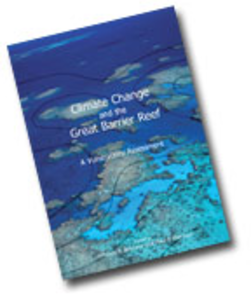Vulnerability of coastal and estuarine habitats in the GBR to climate change
Sheaves, Marcus, Brodie, Jon, Brooke, Brendan, Dale, Pat, Lovelock, Catherine, Waycott, Michelle, Gehrke, Peter, Johnston, Ross, and Baker, Ronald (2007) Vulnerability of coastal and estuarine habitats in the GBR to climate change. In: Johnson, Johanna E., and Marshall, Paul A., (eds.) Climate Change and the Great Barrier Reef: a vulnerability assessment. Great Barrier Reef Marine Park Authority and the Australian Greenhouse Office, Townsville, QLD, Australia, pp. 593-620.
|
PDF (Published Version)
- Published Version
Download (706kB) |
|
![[img]](https://researchonline.jcu.edu.au/8488/2.hassmallThumbnailVersion/1837%2C_5189%2C_8060%2C_8488%2C_8566%2C_12118_Climate_Change_GBR_2007_cover.jpg)
|
Image (JPEG) (Book Cover)
- Cover Image
Download (8kB) |
Abstract
Coastal and estuarine habitats occupy a central place in the functioning of tropical marine ecosystems. Their location at the interface between land and sea means they function to modulate the movement of terrestrial materials (eg freshwater, nutrients and pollutants) into the marine environment. Coastal and estuarine habitats also act as a filter, with functional units such as mangrove forests inhibiting trapping and retaining sediments and nutrients. Coastal habitats are also crucial nursery grounds for many species of fish111 and crustaceans, and act as links in the life cycles of species that migrate between marine and freshwater habitats. Beyond this, their close proximity to population and industrial centres makes them the marine habitats most vulnerable to human impacts.
The east coast of tropical Queensland comprises a diversity of habitats, ranging from freshwater and littoral marshes, through estuaries, to nearshore open oceans and reefs. These habitats do not function alone but are an interlinked coastal ecosystem mosaic (CEM), connected at a variety of spatial, temporal, functional and conceptual scales. This complex mix of habitats is inhabited by one of the most diverse faunas on earth with organisms covering the full taxonomic spectrum, from viruses and bacteria to cetaceans. Unfortunately, detailed ecological knowledge is limited to a very small subset of the range of these organisms, with many species unknown, unidentified or unquantified. Although it is clear species interact in complex ways, our understanding of this is critically deficient. Moreover, many of the individual components are poorly understood, and details of the links between them largely absent.
| Item ID: | 8488 |
|---|---|
| Item Type: | Book Chapter (Non-Commercial) |
| ISBN: | 978-1-876945-61-9 |
| Additional Information: | This publication does not have an abstract. The first two paragraphs of the Introduction are displayed as the abstract. |
| Date Deposited: | 26 Mar 2010 03:18 |
| FoR Codes: | 06 BIOLOGICAL SCIENCES > 0602 Ecology > 060205 Marine and Estuarine Ecology (incl Marine Ichthyology) @ 100% |
| SEO Codes: | 96 ENVIRONMENT > 9603 Climate and Climate Change > 960399 Climate and Climate Change not elsewhere classified @ 100% |
| Downloads: |
Total: 6168 Last 12 Months: 23 |
| More Statistics |



